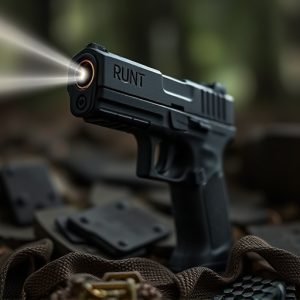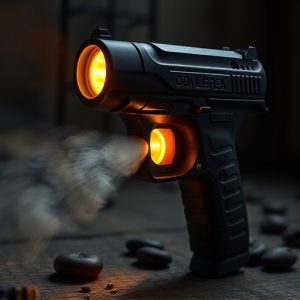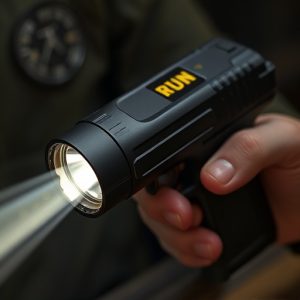Decoding Runt Stun Gun Voltage: A Safety and Effectiveness Guide
A runt stun gun is a compact self-defense device capable of delivering high-voltage electric shocks…….
A runt stun gun is a compact self-defense device capable of delivering high-voltage electric shocks, with voltage levels ranging from 450,000 to over a million volts. The effectiveness of these stun guns lies in their ability to incapacitate an attacker by disrupting muscle control. While the voltage is a critical factor in their performance, it must be considered alongside other features such as amperage, battery longevity, and flashlight lumens for personal protection. Runt stun guns are designed to offer a balance between portability and defensive power, making them suitable for those who prioritize concealability without compromising on safety. When choosing a runt stun gun, it's important to select one with a sufficient voltage output to ensure reliable incapacitation in self-defense situations. Legal compliance is also paramount, as stun gun regulations vary by location and some places have strict controls or bans. Users should be well-versed in the operational mechanics of their runt stun gun and adhere to safety protocols to avoid unintended activations. Proper training is essential for responsible use, which includes understanding how voltage, battery strength, circuitry design, and electrode configuration contribute to a stun gun's overall effectiveness. It's not just the voltage that matters, but how these components work together to provide effective stopping power in self-defense scenarios.
When considering personal safety devices, the role of voltage in runt stun guns emerges as a pivotal aspect. This article delves into the intricacies of their electrical output, offering a comprehensive guide to understanding and utilizing runt stun guns effectively and safely. From the mechanics that dictate their effectiveness to the legal parameters governing their use, we explore the factors that influence voltage and how these devices can be tailored to meet individual defense needs. Additionally, we address prevalent misconceptions surrounding their true electric output, ensuring readers are well-informed about the capabilities of runt stun guns.
Understanding Runt Stun Gun Voltage: A Comprehensive Overview
When examining the specifications of a stun gun colloquially referred to as a “runt” due to its compact size, one must consider the voltage it yields, which is a critical factor in its effectiveness. A stun gun’s voltage dictates its ability to incapacitate an attacker by delivering a high-voltage electric shock that disrupts muscle control. Typically, stun guns designed for personal defense are categorized under low, medium, or high voltage ranges, with the “runt” model often falling within the lower end of these categories. Despite its smaller stature, a runt stun gun harnesses a voltage that can still deliver a powerful and disorienting shock, making it a formidable self-defense tool for those who prefer a more concealable device.
Understanding the voltage of your stun gun is essential when assessing its stopping power against an assailant. The term “runt” does not imply inefficiency; rather, it signifies a smaller and more easily concealed unit. Manufacturers design these devices to maintain a balance between size and shock intensity. A runt stun gun typically operates at a voltage that ranges from 450,000 volts to over a million volts, depending on the model. This high voltage is paired with a low-ampere output, which ensures that the shock delivered is powerful enough for self-defense without causing excessive damage or injury. When selecting a runt stun gun, it’s important to review its voltage specifications along with other features like amperage, battery life, and lumens for any attached flashlight function, to ensure you have a reliable tool for your safety.
The Mechanics of Runt Stun Guns: How Voltage Affects Effectiveness
Runt stun guns are compact and concealable devices designed to incapacitate an attacker by delivering a high-voltage electric shock. Despite their smaller size compared to standard stun guns, they remain effective due to their voltage output. The effectiveness of a runt stun gun is directly linked to its voltage; a higher voltage can increase the potency of the shock, potentially rendering an assailant immobile for a few critical moments, allowing for escape or further defensive action.
The mechanics behind these devices involve a charge stored in the unit’s battery and then released through two electrodes. When activated, the stun gun emits a pulse of electricity at the designated voltage level. This electric current targets the motor nerves that control muscle movement, leading to involuntary muscle contractions. The voltage is crucial as it determines how effectively these muscles are affected, with higher voltages generally causing more intense and longer-lasting muscle spasms. It’s important for users to understand that while a lower voltage may still be effective, the reliability on the device functioning as intended in self-defense situations underscores the importance of considering the voltage specification when selecting a runt stun gun.
Safety and Legal Considerations When Using a Runt Stun Gun
When deploying a runt stun gun for personal safety, it is imperative to be aware of both the device’s capabilities and the legal framework governing its use. These compact stun guns, despite their diminutive size, are designed with a specific voltage output that incapacitates an attacker by delivering a high-voltage, low-ampere electrical shock. The voltage level is crucial as it dictates the effectiveness of the device; typically, runt stun guns operate at around 650,000 volts. Users should familiarize themselves with local laws and regulations to ensure compliance when carrying or using such a device. Legal restrictions may vary by state or country, and in some jurisdictions, stun guns are heavily regulated or even prohibited. Proper handling and storage are also essential to prevent accidental discharge and to maintain the device’s functionality over time. Safety training is recommended to understand how to use a runt stun gun effectively and responsibly, minimizing the risk of harm to oneself or others during an encounter with an aggressor. Users should always consider their surroundings and the potential consequences of using a stun gun in self-defense, ensuring they do so only when it is legally justified and necessary for personal safety.
Choosing the Right Runt Stun Gun for Your Needs: Factors Influencing Voltage
When selecting a runt stun gun that aligns with your personal safety requirements, understanding the factors influencing its voltage is crucial. Runt stun guns are designed to deliver a high-voltage electric shock to incapacitate an attacker, and their effectiveness often correlates with the voltage they can generate. Typically, stun guns come in various voltage levels, ranging from as low as 650,000 volts up to 1,000,000 volts or more. The choice of voltage depends on several factors, including legal restrictions, personal strength, and the potential threat’s size and resistance. Higher voltage models may be more effective against larger or stronger assailants, but they also come with increased brightness and sound, which could startle or disorient an attacker even from a distance. It’s important to consider the legal limitations in your area regarding stun gun voltage when making your selection. Additionally, practice with any runt stun gun you choose is essential to familiarize yourself with its operation and ensure you can deploy it effectively should the need arise. Always prioritize safety and compliance with local laws when acquiring and using a runt stun gun.
Demystifying Myths: The True Potency of Runt Stun Guns' Electric Output
Contrary to certain misconceptions, the effectiveness of a runt stun gun is not solely determined by its voltage. While the electric output is a critical component of its function, the true potency of a stun gun lies in its design and the electrical current it delivers rather than just the voltage it claims to have. Manufacturers often list voltage specifications like 650kV or more, which can lead to confusion among potential users who might believe that higher voltage equates to greater stopping power. However, the actual effectiveness of a stun gun is influenced by various factors, including the battery strength, the circuitry design, and the electrode configuration. A well-designed runt stun gun with lower voltage but optimized current can incapacitate an assailant as effectively as a larger device with higher voltage but subpar construction. Users should prioritize understanding how the stun gun’s components work together rather than focusing solely on the listed voltage when assessing its defensive capabilities. It’s crucial to recognize that the stopping power of a runt stun gun is not just a matter of voltage, and users can trust these devices for self-defense based on their proven performance in real-world scenarios.


